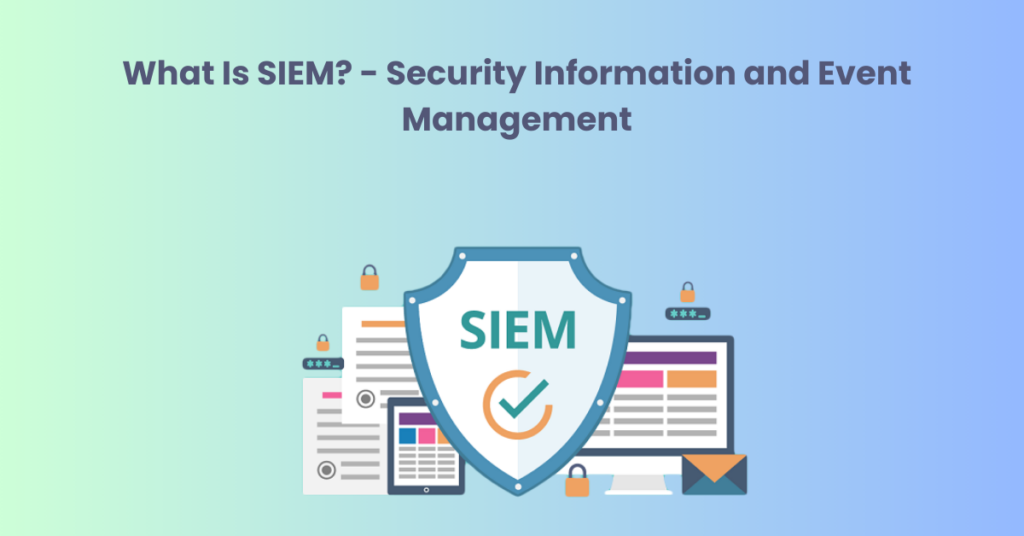What is SIEM (Security Information and Event Management)? A Comprehensive Guide

In an era where cyber threats are evolving rapidly, organizations must adopt proactive measures to safeguard their sensitive data and ensure compliance with various regulations. One of the most effective strategies for achieving these goals is the implementation of a Security Information and Event Management (SIEM) system. This blog post will explore what SIEM is, how it works, its benefits, and common use cases.
What is SIEM?
Security Information and Event Management (SIEM) is a comprehensive approach to cybersecurity that combines security information management (SIM) and security event management (SEM). SIEM systems collect, analyze, and correlate security data from various sources within an organization’s IT infrastructure, including servers, network devices, domain controllers, and more. This enables organizations to detect, analyze, and respond to security incidents in real time.
How Does SIEM Work?
SIEM operates through a multi-step process that involves data collection, normalization, analysis, and reporting. Here’s how it generally works:
- Data Collection: SIEM systems aggregate log and event data from a variety of sources, including firewalls, intrusion detection systems (IDS), antivirus software, and more. This data collection can occur in real time or through scheduled data retrieval.
- Data Normalization: The collected data is normalized to ensure consistency across different formats and sources. This allows the SIEM system to analyze diverse data types effectively.
- Data Analysis: SIEM systems use advanced analytics, machine learning, and correlation rules to identify patterns and anomalies in the data. This analysis helps in detecting potential security threats or breaches.
- Alerting and Reporting: When a potential threat is identified, the SIEM system generates alerts for security teams. It also provides detailed reports that can be used for compliance audits and forensic investigations.
- Incident Response: SIEM systems often integrate with security orchestration and automation tools to facilitate incident response. This enables organizations to automate responses to common threats, reducing the time to mitigate incidents.
Benefits of Using SIEM
- Enhanced Threat Detection: SIEM systems provide real-time monitoring and analysis of security events, allowing organizations to detect and respond to threats more quickly.
- Centralized Security Management: By aggregating security data from multiple sources, SIEM offers a centralized view of an organization’s security posture, making it easier to manage and monitor security incidents.
- Compliance Support: Many organizations must adhere to various regulatory requirements (such as GDPR, HIPAA, and PCI DSS). SIEM systems can assist in compliance by providing logs, reports, and documentation for audits.
- Improved Incident Response: With automated alerts and incident response capabilities, SIEM helps organizations respond to security incidents swiftly, minimizing potential damage.
- Historical Data Analysis: SIEM systems store historical log data, enabling organizations to conduct forensic analysis and identify trends or recurring security issues.
Common Use Cases for SIEM
- Threat Detection and Response: SIEM is widely used for real-time monitoring and alerting, helping organizations quickly identify and respond to security threats.
- Compliance Monitoring: Organizations use SIEM to generate reports and maintain logs for compliance with various regulations, ensuring that they meet industry standards.
- Incident Investigation: SIEM systems provide security teams with tools to analyze and investigate security incidents, helping them understand the nature and scope of attacks.
- Behavioral Analysis: By analyzing user behavior and network traffic, SIEM can identify unusual activities that may indicate a security breach.
- Log Management: SIEM helps organizations manage their log data effectively, ensuring that they retain necessary logs for audits and investigations.
Conclusion
A Security Information and Event Management (SIEM) system is an essential component of modern cybersecurity strategies. By providing real-time monitoring, threat detection, and compliance support, SIEM empowers organizations to safeguard their sensitive data and respond effectively to security incidents. As cyber threats continue to evolve, investing in a robust SIEM solution is a proactive measure to enhance your organization’s security posture.
